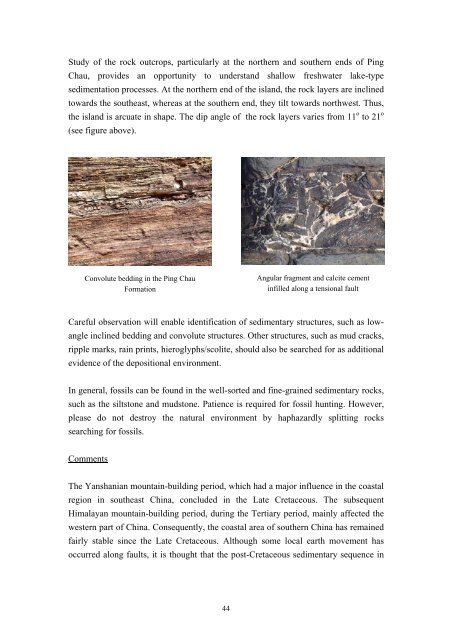Hong Kong Geology Guide Book Geotechnical Engineering Office ...
Hong Kong Geology Guide Book Geotechnical Engineering Office ...
Hong Kong Geology Guide Book Geotechnical Engineering Office ...
You also want an ePaper? Increase the reach of your titles
YUMPU automatically turns print PDFs into web optimized ePapers that Google loves.
Study of the rock outcrops, particularly at the northern and southern ends of Ping<br />
Chau, provides an opportunity to understand shallow freshwater lake-type<br />
sedimentation processes. At the northern end of the island, the rock layers are inclined<br />
towards the southeast, whereas at the southern end, they tilt towards northwest. Thus,<br />
the island is arcuate in shape. The dip angle of the rock layers varies from 11 o to 21 o<br />
(see<br />
figure above).<br />
Convolute bedding in the Ping Chau<br />
Formation<br />
Careful observation will enable identification of sedimentary structures, such as low-<br />
angle inclined bedding and convolute structures. Other structures, such as mud cracks,<br />
ripple marks, rain prints, hieroglyphs/scolite, should also be searched for as additional<br />
evidence of the depositional environment.<br />
In general, fossils can be found in the well-sorted and fine-grained sedimentary rocks,<br />
such as the siltstone and mudstone. Patience is required for fossil hunting. However,<br />
please do not destroy the natural environment by haphazardly splitting rocks<br />
searching for fossils.<br />
Comments<br />
Angular fragment and calcite cement<br />
infilled along a tensional fault<br />
The Yanshanian mountain-building period, which<br />
had a major influence in the coastal<br />
region in southeast China, concluded in the Late Cretaceous. The subsequent<br />
Himalayan mountain-building period, during the Tertiary period, mainly affected the<br />
western part of China. Consequently, the coastal area of southern China has remained<br />
fairly stable since the Late Cretaceous. Although some local earth movement has<br />
occurred along faults, it is thought that the post-Cretaceous sedimentary sequence in<br />
44

















